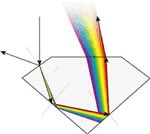 Cut has the biggest impact on the beauty of diamonds and sometimes least amount of difference in their price compared to color, clarity and carat weight. The word cut has several meanings when it comes to diamonds. The cut of a diamond does not just mean its shape (round brilliant, princess, oval, cushion, etc.) but also addresses the symmetry, polishing, angles and the proportions of each physical aspect of the diamond.
Cut has the biggest impact on the beauty of diamonds and sometimes least amount of difference in their price compared to color, clarity and carat weight. The word cut has several meanings when it comes to diamonds. The cut of a diamond does not just mean its shape (round brilliant, princess, oval, cushion, etc.) but also addresses the symmetry, polishing, angles and the proportions of each physical aspect of the diamond.
The cut determines the diamond’s sparkle and brilliance. A properly cut diamond will refract the light that enters the diamond and return it through the top to produce the much desired sparkle. The angles have to be exactly right to optimize the reflection of light back to your eye.
Proportions
Different diamond cutters, each with different levels of skill, cut diamonds. Each rough diamond crystal has its own distinct inclusions occurring at random locations. Diamond cutters are trying to cut the biggest and heaviest diamond from the rough crystal. Cutting diamonds to the best possible cut usually means losing diamond carat weight in the cutting process. There is always a compromise between beauty and size. Some cutters have more skill than others have and are willing to take the extra time to do it right.
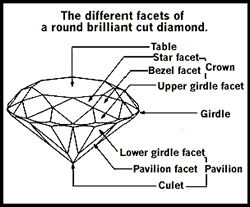 The typical brilliant cut diamond is cut with 58 facets, 33 on the crown and 25 on the pavilion. On a well-proportioned stone, these facets will be uniform and symmetrical. If they are not, the diamond’s ability to refract and reflect light will suffer.
The typical brilliant cut diamond is cut with 58 facets, 33 on the crown and 25 on the pavilion. On a well-proportioned stone, these facets will be uniform and symmetrical. If they are not, the diamond’s ability to refract and reflect light will suffer.
A well-cut diamond loses more of the rough diamond than deep or shallow cuts as illustrated below.
- Natural rough diamond
- Two diamonds cut with well-cut proportions. For example this may yield a larger diamond of 1 carat and a smaller diamond of 0.5 carat
- Two diamonds cut to retain maximum carat weight and not ideal sparkle proportions. For example, this may yield two diamonds of around one carat.
Warning: A poorly cut diamond just will not look right to the eye. Unfortunately, the majority of diamonds on the market are poorly proportioned.
When searching for a great cut, the two key numbers are the depth percentage and the table percentage.

Depth percentage is the depth of the diamond (table to culet) divided by the width of the diamond. The higher the depth percentage, the deeper the stone looks in appearance. The lower the depth percentage the shallower the stone looks. For example, a diamond with depth of 4.09 mm and width (average diameter) of 6.75 mm equals a depth percentage of 60.6%. For a round diamond, a good target for the depth percentage is 59-62.5%.
Table percentage is the width of the table divided by the width of the diamond. The higher the number, the bigger the table looks. The lower the number, the smaller the table looks. For example, a diamond with table of 3.91 mm and width (average diameter) of 6.75 mm equals a table percentage of 57%. For a round diamond, a good target for the table percentage is 53-59%. Do not confuse small table with small diameter. In general, you want the bigger size diameter and the smaller table percentage for the most beautiful round diamonds.
Out of Round: It is interesting to note that “round” diamonds are usually not perfect circles. The length and width measurements for a round are both diameter measurements and will be different for an out-of-round shape. If the length is greater than the width by more than .10 millimeters, the diamond has not been cut well and should be avoided. For two-carat stones, the acceptable deviation is 0.12 millimeters.
Advice: At Diamond Source of Virginia, we usually make our preliminary search for round brilliant diamonds that have depth 59-62.5% and table 53-59%. Then we seek the best values in terms of big diameter, great proportions and at least Good polish and symmetry. When the information is available, we like to find diamonds with crown height 14-17% and pavilion depth 42-44%. Ultimately, we rely on our personal inspection to assess the diamond’s appearance, including sparkle and brilliance.
Ideal Cut
The diamond grading laboratories like the GIA and AGS have been researching cut proportions for many years but there is still no industry agreement on what constitutes the best cut parameters for round brilliant diamonds.

This is hard for most diamond shoppers to understand. There are straightforward standards for grading color and clarity, so why is it so hard for the diamond industry to agree on what proportions are “ideal” for round brilliant diamonds? Several key issues in determining “ideal” cut are a challenge.
1) Part of the problem is that the grading laboratories themselves are in fierce competition with each other so there is an incentive to be different than the competitor. The major grading laboratories (GIA, AGS, EGL, IGI and PGS) have the same basis for grading color, clarity, measurements and carat weight. It is the area of categorizing cut where they differ.
Click here to learn more about the history of cut grading and the continuing evolution of the art of establishing cut grades.
2) Diamond consumers and a small percentage of the diamond industry have always wanted cut grades. However, the majority of the diamond industry has fought the concept of cut grades because they perceive cut grades will be the final step in making diamonds a commodity. Diamond cutters traditionally make more money by cutting the heaviest and quickest gem from their rough diamond crystals. Cutting a diamond to the proportions and precision approaching some “ideal” standard takes 4 to 10 times as much labor and often results is less finished carat weight.
The retail jeweler traditionally bought the least expensive inventory they thought they could sell. This often meant buying diamonds with average or even inferior cut proportions. Without cut grades or the diamond education available online, jewelry stores relied on special lighting and the consumer’s lack of knowledge to sell mediocre diamonds. Now many retailers dread the diamond shopper walking into their store, carrying printouts from online diamond educations web sites, and demanding the highest cut grades.
3) Most of the characteristics about what is considered a beautifully cut diamond have to do with how light is handled by the diamond. It is only in recent years that technology has the ability to measure and quantify the various aspects of a diamond’s light performance as perceived by the human eye. Light performance is a complicated issue because the results for a particular diamond vary depending on the lighting conditions, any movement, and the location of the diamond in relationship to the observer.
4) Perhaps the most challenging obstacle in the quest for the diamond cut grades is that people perceive beauty differently. The old saying “beauty is in the eye of the beholder” is true for judging the beauty of a sunset, a painting in a museum, a baby’s smile or a finished diamond. While it might be possible for a majority to agree on what constitutes beauty and how to rank it, there will always be differences of opinion.
Learn more about the different Cut Grade Systems
- GIA Cut Grade System
- AGS Cut Grade System
- Holloway Cut Adviser
- AGA Cut Grades
- EGL Cut Grades
- PGS Cut Grades
- IGI Cut Grades
- HRD Cut Grades
- SGTL Cut Grades
Regardless of the cut grade research to date or in the future, only you can determine what diamond is most appealing to you. There is only one vote that counts – yours! We encourage you to examine diamonds in person so you can determine what visual aspects of a diamond are important for you.
Finish Grading
Finish grades represent the quality of the surface condition (polish) and the size, shape and placement of the facets, including the evenness of the outline (symmetry).
Finish: Polish
 The polish grade is a measure of the visibility of polishing lines on the surface of the diamond when viewed with 10X magnification or the unaided eye. These polish lines are caused by microscopic diamond crystals pulled across the diamond facet by the polishing wheel during the diamond cutting process. Polish lines are similar to the streaks left on a car after it is waxed.
The polish grade is a measure of the visibility of polishing lines on the surface of the diamond when viewed with 10X magnification or the unaided eye. These polish lines are caused by microscopic diamond crystals pulled across the diamond facet by the polishing wheel during the diamond cutting process. Polish lines are similar to the streaks left on a car after it is waxed.
Polish for diamonds is usually graded into five categories: Excellent, Very Good, Good, Fair and Poor. For round brilliant and fancy-shaped diamonds, a polish grade of Good or better is generally preferred.
Click here for more information about Polish Finish Grades
Finish: Symmetry
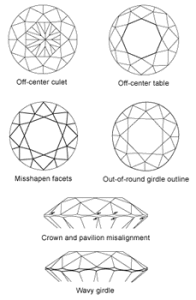 Symmetry refers to the external balance and alignment of the facets. When you look at real diamonds, girdles are not always perfectly round and tables are not always perfect octagons. Sometimes facets are distorted, and sometimes they look as though their points have been lopped off. Sometimes the table tilts towards the girdle plane; sometimes it is off-center, and sometimes the girdle looks more like a warped record than a flat disc. The culet may not be centered, and the bezels and pavilion mains may not be directly opposite each other. These are aspects of symmetry.
Symmetry refers to the external balance and alignment of the facets. When you look at real diamonds, girdles are not always perfectly round and tables are not always perfect octagons. Sometimes facets are distorted, and sometimes they look as though their points have been lopped off. Sometimes the table tilts towards the girdle plane; sometimes it is off-center, and sometimes the girdle looks more like a warped record than a flat disc. The culet may not be centered, and the bezels and pavilion mains may not be directly opposite each other. These are aspects of symmetry.
Symmetry for diamonds is usually graded into five categories: Excellent, Very Good, Good, Fair and Poor.
For round brilliant diamonds, a symmetry grade of Very Good or better is generally preferred. For fancy-shaped diamonds, a symmetry grade of Good or better is generally preferred.
Click here for more information about Symmetry Finish Grades
Finish: Price Impact
Polish and symmetry have relatively little impact on a diamond’s appearance but have a considerable influence on the price of diamonds. Based on a study of round diamonds, here are the price differences for various combinations of polish and symmetry ratings compared to the Good ratings, which generally mean polish and symmetry features are not visible to the eye.
Polish & Symmetry Grades
Price Difference
G - G
0%
VG - G
+2%
VG - VG
+3.7%
EX - VG
+5.8%
EX - EX
+13.1%
This significant price impact is largely because the terms used are simple and easy to understand. Excellent or Good, which would most people prefer? The fact is it is usually impossible to tell the difference with a microscope to the diamond shopper. Because there is so little cut information on diamond certifications, consumers jump on any indication of quality, especially if they are easy to understand. The result is these minor finish ratings have more significant impact on diamond prices than they probably should.
Advice: Look for diamonds with at least Good polish and symmetry. While we are always seeking high ratings when possible, you will not be able to see the difference between ID, EX, VG or G polish ratings with your eye and probably not with a microscope. For round diamonds we like at least VG symmetry ratings when possible. Diamonds with ID or EX ratings for both polish and symmetry are prices higher because some shoppers are willing to pay more for those letters on the certification. We believe it is much more important to put you money in things you can see (bigger size, higher color and especially better cut) rather than minor finish ratings that are not visible to the eye.
Hearts and Arrows
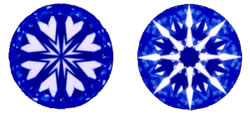 In Japan in the 1980’s it was discovered that when a round diamond with exceptional symmetry was viewed from the bottom through a Firescope™ a pattern of hearts was displayed.
In Japan in the 1980’s it was discovered that when a round diamond with exceptional symmetry was viewed from the bottom through a Firescope™ a pattern of hearts was displayed.
 A special viewer was developed to display a pattern of eight gray arrowheads when the diamond is viewed from the top and a pattern of eight heart shapes when viewed from the bottom of the diamond. This pattern is called Hearts & Arrows (H&A). Diamonds with Hearts and Arrows patterns became very popular in Japan. In the mid 1990’s the trend arrived in the USA.
A special viewer was developed to display a pattern of eight gray arrowheads when the diamond is viewed from the top and a pattern of eight heart shapes when viewed from the bottom of the diamond. This pattern is called Hearts & Arrows (H&A). Diamonds with Hearts and Arrows patterns became very popular in Japan. In the mid 1990’s the trend arrived in the USA.
The Hearts & Arrows viewer is a useful tool in determining the optical symmetry of a diamond, which is by the internal movement of light through the diamond and how it is reflected by the size, shape and placement of facets. This Optical Symmetry is different than the Symmetry Grading on a laboratory grading report that assesses the “neatness” of facet intersections and external placement.
Click here for more information about Hearts & Arrows
Girdle
The girdle is the narrow section of the diamond separating the crown from the pavilion and functions as the diamond’s setting edge as well as the blunt surface reducing the risk of damage from a blow to that edge. The girdle is measured in relative thickness and the type of finish (polished, faceted, none).
If the girdle is Extremely Thin in these areas, the diamond could be prone to chipping or bruising. Diamonds with Extremely Thick girdles weigh more for their size and may not be as bright as they should be. The bigger girdles are also more visible, especially if they are not faceted.
For round brilliant diamonds, facetted girdles with a thickness in the Thin to Slightly Thick range are generally preferred.
Click here for more information about the Girdle
Culet
The facets at the bottom of the pavilion in diamonds are usually intended to come together forming a perfect point. Sometimes the cutter polishes a small facet at the point so that it does not get chipped and this facet is called a culet (pronounced que-let).
instead of passing through like a window. If a culet, which is parallel to the table facet, is too big, the result is that you can see right out the ‘hole’ the culet appears to make in the center bottom of the diamond. Many large, old fashion shapes like cushions or old miners have larger culets and a window through the diamond.
The culet size determined with 10X magnification, is listed on a certification as pointed (none), very small, small, medium, slightly large, large, very large or extremely large. Most culets that are medium or smaller are not visible to the naked eye.
Click here for more information about the Culet
Fancy Shape Cut
When selecting a fancy shaped diamond, all of the 4C’s apply as they do for a round diamond. However, several other considerations are important for fancy shapes such as the overall appearance of the outline of the girdle of the stone, the “bow tie” effect and the length-to-width ratio.
Currently the only grading laboratory that provides cut grades for fancy shaped diamonds is the AGS. They introduced a cut grade for princess cut diamonds in early 2005 and a cut grade for emerald cut in the third quarter of 2006. We expect the AGS to be introducing additional cut grades for other fancy shapes in the upcoming months.
- Princess Cut Grade
- Emerald Cut Grade
See our cut recommendations for each of the classic fancy shapes.
Probably the most important aspect for a fancy cut is the general appearance to your eye and that it is appealing and symmetrical. In many fancy shaped diamonds (marquise, pear, oval, emerald and heart shaped), the pavilion facets do not culminate to a point at the tip of the pavilion as they do for a round. Instead, they form an edge, called the “keel line.” This line should be centered in the diamond and this form of “culet” should still be as small as possible.
Girdle width will vary between greater extremes on some fancy shapes compared to the round brilliant. These include the marquise, pear and heart, where the girdle tends to be thick or extremely thick at the tips of the stone and in the cleft of the heart-shaped cut. Also, the princess cut, which has square corners, may have an extremely thin girdle in these areas. Since the girdles vary with greater frequency in fancy shapes, attention needs to be paid to extremely thin and extremely thick girdles to avoid danger of chipping or excessive weight.
Bow Tie
 The bow tie effect, observed with the unaided eye, is frequently found in marquise, oval, radiant, pear and some heart-shaped diamonds, and is considered a negative factor if prominent. It arises from the variations in the pavilion facet angles required in cutting stones that are longer than they are wide.
The bow tie effect, observed with the unaided eye, is frequently found in marquise, oval, radiant, pear and some heart-shaped diamonds, and is considered a negative factor if prominent. It arises from the variations in the pavilion facet angles required in cutting stones that are longer than they are wide.
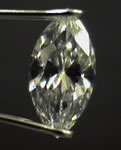
 The bow tie looks like two dark triangular shapes joined at the point in the center of the stone and looks like a man’s black bow tie. While almost every elongated stone has some “bow tie” shadowing, the diamond shopper’s goal is to find a diamond with a bow tie that is minimal, absent or not a distraction. This is something that specifications of the diamond do not reveal, only personal inspection.
The bow tie looks like two dark triangular shapes joined at the point in the center of the stone and looks like a man’s black bow tie. While almost every elongated stone has some “bow tie” shadowing, the diamond shopper’s goal is to find a diamond with a bow tie that is minimal, absent or not a distraction. This is something that specifications of the diamond do not reveal, only personal inspection.


